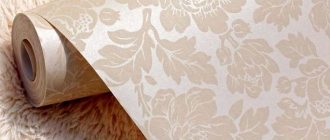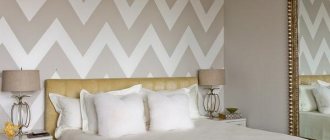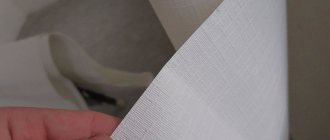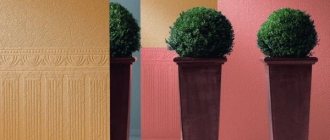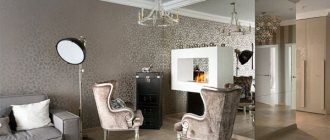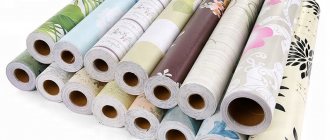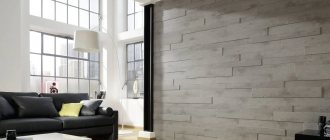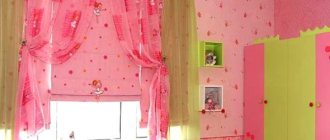Today, to decorate walls in an apartment or house, most buyers choose wallpaper: non-woven, paper, liquid - their range is incredibly diverse. Today, in caring for their own health and comfort, many people prefer, first of all, to use completely safe materials in their homes, and more often than others the question arises: is vinyl wallpaper harmful to health? But just a few years ago, few people thought about how dangerous or useful such finishing is.
Origin of opinion
Why do people think that vinyl wallpaper is dangerous?
The point is in their composition. They have two layers. The first is the bottom, there are wallpapers on a paper basis or, as an option, on a non-woven basis. There are usually no complaints about him. But the top one, which is made from polyvinyl chloride, worries many, as it is of purely chemical origin. Are people right who believe that such wallpaper is dangerous? Partially. It's all about the properties of this layer. It is waterproof and also steamproof.
Typical use of two types of wallpaper: plain and patterned
On the one hand, this is an extremely positive quality, which allows the coating to be very easy to clean. It can be easily washed and can be cleaned without any particular difficulty. But this property also turns out to be a disadvantage. After all, if there is no air exchange, then condensation begins to accumulate under the wallpaper.
It is this that becomes the source for the development of quite dangerous pathogenic fungi. They usually cause the main harm and cause health hazards, which even doctors warn about. An allergy may occur to these fungi, then the health consequences may be different, but definitely only negative.
Non-woven wallpaper: what is included
Non-woven wallpaper is widely used for decorative decoration of premises. They have a beautiful appearance and a large selection, which attracts buyers. The characteristics and properties of non-woven wallpaper are determined by its composition.
Composition of non-woven wallpaper:
- Cellulose makes up 70 percent of the composition. During production, they are arranged in a special way, which ensures their high strength and reliability.
- Binders make up 30 percent of the total composition.
Modern wallpaper production technology makes them especially strong, durable, and wear-resistant. Depending on the materials used, wallpapers are divided into several types.
Types of non-woven wallpaper
- Non-woven. They consist exclusively of one component - non-woven fabric. They have many layers. The decorative layer is a relief coating with a characteristic pattern. They last a long time and can be repainted.
- On a non-woven basis. The top layer of such wallpaper consists of vinyl, paper or textile.
The main characteristics of wallpaper are determined by the composition of the components used in their manufacture. When caring for non-woven wallpaper, you can use detergents and cleaning tools.
New wallpapers
It was previously mentioned that outdated types of wallpaper are harmful. But are the new generation vinyl wallpapers, which are made taking into account all the latest achievements, harmful? After all, it is not so difficult to ensure that such wallpaper is not dangerous; it is enough to use environmentally friendly materials, and also make the surface breathable and microporous.
This can be done with modern technologies, but it is important to understand that this is unlikely to be realistically attributed to cheap products from little-known companies. You need to focus only on large brands from countries that have been successfully producing such wallpaper for a long time, using modern approaches to their production. This could be, for example, Finland, Germany, Sweden and so on; usually the level of quality in these countries is more than high.
Up close, the pattern of the wallpaper seems complex, but from a distance it resembles a monochromatic version
You can also understand that this wallpaper is not particularly hazardous to health by the indication on the label that the vinyl is microporous. The composition may also contain various antifungal components, which is also very important, because then the likelihood of the appearance of all kinds of negative formations decreases significantly.
RESULT
Guys, to summarize, vinyl wallpaper from different manufacturers affects health in different ways. You shouldn’t rush to the cheapest options; it’s better to look towards Europe or Russia. It is advisable that the packaging bear perforation and environmental friendliness symbols. After a couple or three weeks, such wallpaper will be no more harmful than plastic windows in your apartment and will have virtually no effect on your health.
And lastly, a friend of mine did a budget renovation, hung the cheapest version of wallpaper, and also boasted that he bought a meter roll for 150 rubles. So, they were never able to move into this apartment, because it smelled terrible! And after 5 – 10 minutes my head started to hurt! Personally, I chose a more expensive one for my apartment; a roll cost about 800 - 1000 rubles. They did not smell even immediately after gluing them. So choose wisely, in the beginning - sniff in the truest sense of the word.
And that’s all for me, read our construction blog.
Other selection criteria
If you are selecting vinyl wallpaper, then the selection criteria that will help you choose the best option may be much more than just the name of the country of origin and the inscriptions on the labels.
Modern design involves a mixture of different materials
The first important step when choosing is to personally familiarize yourself with a sample of the wallpaper that you intend to purchase. Be sure to buy the wallpaper in person, and when you do, smell it. This is a simple and even primitive method, but it is very effective.
If the wallpaper is of poor quality, if its material is harmful to humans and contains negative fumes, then such products will immediately smell sharp and extremely unpleasant.
Many people are skeptical about this method, but in fact, you can verify its objectivity using a very simple method - smell the most expensive European vinyl wallpaper that is available in the store, and then, for contrast, the cheapest. The difference will be noticeable immediately, unless, of course, you have a runny nose. If the smell is already present, then it’s easy to imagine how it will spread throughout the apartment after purchasing the wallpaper and leaving it on the walls for a long time.
One type of vinyl allows you to perfectly imitate natural finishing materials
If you have strong doubts that you can choose the wallpaper correctly and still want to take it, you can do it this way. After all, the house already contains a lot of PVC, for example, in chipboards, plastic windows and other elements.
But then try to glue such wallpaper in those rooms where you traditionally spend minimal time, or where there is good ventilation (for example, in the kitchen, where there is an exhaust hood), but it’s best not to experiment with the children’s room, only environmentally friendly ones are needed there wallpaper that is not dangerous.
Types of eco-friendly wallpaper
As mentioned above, safe wallpaper should be made from natural or non-toxic artificial materials. Depending on the raw materials used in production, they are divided into several types.
Vegetable
At the moment, wallpaper made from bamboo, reeds and other plants are one of the most popular options. Their soft texture makes the room warm and cozy.
The most common are bamboo. It is essentially a tube-shaped grass that grows very quickly, so cutting it down does not harm the flora and fauna. In addition, the material does not contain resins or other components. Bamboo is used to make not only wallpaper, but also furniture, flooring, and so on, so it can be used to create a completely safe room.
Woody
Despite the similarity with the previous type, environmentally friendly wood wallpaper belongs to a separate group. In most cases, they are a thin layer of flexible wood that can be rolled up.
There are many options for raw materials for this wallpaper, but each of them is natural and environmentally friendly. In addition, such wood is quickly replenished in nature.
Wood always looks rich and noble, so the materials also carry a visual load. The front surface can be decorated with carvings or inlays; in some cases, wallpaper is painted with natural substances.
Paper
Such wallpaper can be made from parchment, plain or rice paper. The modern market offers a huge range of models, both manual and conveyor-made. When choosing, you need to carefully study the composition; some unscrupulous manufacturers use unnatural dyes, vinyl, formaldehyde and other harmful substances to reduce costs.
The paper itself must be certified by the Forest Stewardship Council. If it was decided to order foreign-made products, then they must be marked with the FSC inscription with the image of a tree with a tick. These documents confirm that the wallpaper was made from raw materials grown in responsibly managed forests, and therefore does not contain harmful substances.
Made from recycled materials
This wallpaper is made from recycled paper. These products cannot be called natural; their production involves many technological processes, but the end result is an environmentally friendly material. In addition, the production of such products reduces the amount of waste and the level of wood extraction.
Textile
Fabric wallpaper can consist entirely of cotton, linen, silk and other fibers or be made using polyester, viscose and other synthetics. In the first case, we are talking about an expensive and completely natural base. Textile wallpaper made from artificial materials is characterized by lower cost, increased performance characteristics, and so on. Both types are absolutely safe for health.
Non-woven
Interlining is a non-toxic mixture of natural and synthetic fibers. Wallpaper breathes well and can be cleaned wet. Ideal for bathrooms, saunas, kitchens and other similar spaces.
Made from fiberglass
Such products contain practically no organic materials. They are made from the same raw materials as ordinary glass, therefore they are chemically inert, making them resistant to detergents and abrasion.
Cork and other coverings
Cork products are made from paper and have antistatic properties. They are harmless and lightweight, so they are often used in interior decoration.
You can also often find products made from natural or artificial leather. This is a relatively expensive material, but it also looks good.
There is an opinion that eco-wallpapers should be made only from natural raw materials. This is partly true, but there are also synthetics that are absolutely safe for health and do not cause allergies.
Harm of non-woven wallpaper
Real non-woven wallpaper does not cause harm and is a high-quality finishing material, but nowadays the manufacturer, in order to reduce the cost of its product and be more competitive in the materials market, uses some tricks. Some vinyl wallpapers on a non-woven basis have been invented, which are called “non-woven”.
It is this vinyl that is dangerous to human health. As a result of combustion, it releases formaldehyde, which in turn reacts with human blood, causing irreversible consequences in the organs. Here are the organs that are negatively affected by formaldehyde: the central nervous system, skin, respiratory tract, reproductive organs, pathological changes in genetic material. Ingestion of 70 to 90 ml of formaldehyde is fatal.
The glue selected for gluing non-woven wallpaper can also be dangerous. It is important to approach the choice of glue seriously and responsibly, check the manufacturer, read the instructions, and consult with experts in this industry. After repair work, it is important to thoroughly ventilate the room before using it for domestic purposes.
Be especially careful when choosing wallpaper. Well-known manufacturers value their reputation by constantly conducting relevant research. Before purchasing wallpaper, be sure to ask the seller if there is a certificate of conformity and a sanitary-epidemiological certificate for the product. A conscientious seller will certainly satisfy your curiosity by providing such documents.
You should also pay attention to the structure of the wallpaper. Real non-woven wallpaper has a hard and dense texture, which cannot be said about a fake. Their texture is soft and easily damaged when pressed, for example with a fingernail.
And the most harmless of the negative factors of such wallpapers can be called their tendency to accumulate dust in residential and office spaces - this happens due to the textured surface of the wallpaper. This is felt especially acutely by asthmatics, people with respiratory diseases, and allergy sufferers. This problem can be solved by frequent wet cleaning of surfaces where such wallpaper is pasted.
When choosing wallpaper, look for special characteristics such as breathability (“breathable wallpaper”). The absence of this property contributes to the appearance of a fungus that is dangerous to health.
How to choose non-woven wallpaper
Before purchasing a finishing material for walls, you need to decide on its type. If you choose non-woven wallpaper for painting, you should take into account the additional costs of purchasing paint, and possibly paying for the services of painters. If you don’t plan on additional expenses, buy ready-made wallpaper with a pattern.
When choosing wallpaper, carefully read the information on the label
To avoid troubles and choose really high-quality non-woven wallpaper, follow these rules:
Carefully examine the cut of the roll - if it has a fibrous structure, this indicates that this is real non-woven wallpaper. When studying the label icons, pay attention to the fact that non-woven wallpaper is glued in a special way. The glue is not applied to the back side, but directly to the wall. Products based on non-woven fabric are easily deformed and damaged, while high-quality wallpaper has a hard and dense outer texture. Keep in mind that hot-stamped non-woven wallpaper is completely devoid of air permeability. If you are looking for “breathable” non-woven wallpaper, then ask sellers for wallpaper with perforations
Non-woven wallpaper with perforation has a special icon. A roll of non-woven wallpaper is approximately two to three times more expensive than vinyl. Therefore, if you want to purchase high-quality finishing material, pay attention to its cost - it cannot be cheap. Give preference to trusted manufacturers and purchase products in specialized stores, and also require a quality certificate.
Damage to vinyl wallpaper
The situation here is especially deplorable, and what you find out may upset you. At first glance, vinyl wallpaper is a very interesting alternative to its expensive and natural counterparts. They practically do not fade in the sun, are quite durable, can be subjected to wet cleaning, and most importantly, they hide significant imperfections in the walls, that is, you can neglect the seemingly obligatory procedure of preparing the walls before gluing.
But the paint on vinyl wallpaper contains zinc and copper compounds, which are safely released into the environment, that is, into the rooms of our apartment. Moreover, the thicker and denser the vinyl layer, the later it begins to release harmful substances. You can conduct a simple experiment: when choosing wallpaper, sniff the individual rolls. The smell of turpentine and acetone is a clear sign of low quality specimens.
Pay special attention to the presence of some signs on the wallpaper. The presence of micropores and a sign of environmental safety. The first indicates the ability of the wallpaper to allow air to pass through, and the second indicates its safe use and absence of harm during operation.
However, this was all about operation without a fire situation. This type of wallpaper can ignite at temperatures from 160-200 degrees Celsius, which strictly violates fire resistance requirements.
Did you know that according to statistics, during fires, 60.3% of deaths occur precisely due to asphyxiation by various gases? When vinyl burns, hydrogen chlorine is also released, which, when inhaled, forms hydrochloric acid in the respiratory system, which is incompatible with human life.
At the State Scientific Institute of Chemistry and Technology of Elementary Organic Compounds, an experiment was conducted with five samples of vinyl wallpaper on a paper and non-woven basis from the same toxicity group. All selected wallpapers were included in the same price category. As a result, experts strongly recommend avoiding the use of vinyl wallpaper. When wallpaper with a polymer coating burns, carbon dioxide, carbon monoxide, hydrogen chloride, cyanide compounds and other hazardous substances will be released.
But what kind of wallpaper should you put up then? To answer this question, experts give recommendations on the use and application of fiberglass wallpaper. Fiberglass is an absolutely safe material for everyday use and is also resistant to fire situations. They have the highest fire safety ratings: European Union B, S1-D0; Germany A1; UK 0; France M1; Russia G1 V1 T1 D1 RP1.
And finally, some statistics. According to the World Health Organization, indoor air is 5 times more toxic than outdoor air. And if a person lives in an unfavorable area, an industrial zone, along a busy road, then the situation gets worse. It is worth paying special attention to the ventilation system of the premises, especially for those who have small children.
Don’t go after cheap prices, choose high-quality wallpaper and contact us for wallpapering services!
Types of wallpaper, features of choice
Before moving on to a review of the classic types of wallpaper suitable for a large room, we note two standard sizes of wallpaper: 0.53 m and 1.06 m. As you probably already guessed, it will be easier to glue wallpaper measuring 106 centimeters in a large room, since you will get half as many pieces. Larger wallpapers, contrary to prejudice, stick to the wall much better because they have a non-woven backing.
Paper
Many experts believe that the age of paper wallpaper is over, but this is not entirely true. The modern trend of environmental friendliness is taking over wallpaper made from paper. By hanging such wallpaper in your large room, you will create a fresh and comfortable interior. The main disadvantage will be the rapid deterioration of the appearance of the wallpaper. Yes, if you want to maintain a decent appearance for your living room, you will have to re-paste the wallpaper at least once every 5-10 years.
Wallpaper made from natural materials does not spoil the interior at all
Vinyl
In this case, we will talk about paper-based vinyl wallpaper, the size of which is 53cm. The quality characteristics of such paintings will allow you to make repairs for many years to come. Vinyl is washable and cleanable, has interesting textures and colors, is safe, and does not require undue attention.
Even very demanding people who create their own unique interior will be able to choose such wallpaper for their living room. We would consider the disadvantages of not being the easiest to paste, since the wallpaper is heavy, and the paper backing cannot always handle it without the proper amount of glue. In addition, vinyl blocks air circulation between the wall and the room.
Using silk-screen wallpaper to create a romantic atmosphere in the living room
Non-woven
Long-length vinyl wallpapers are always supplied with a non-woven backing. This wallpaper is probably the most suitable for hanging in a living room. Non-woven wallpapers are environmentally friendly, have the largest range of colors and patterns, are easy to apply, wear-resistant and durable, and they look amazing on the wall.
Leading wallpaper factories produce real masterpieces of wallpaper in their collections, but each of them brings its own flavor. Choosing non-woven wallpaper for a large room will not be difficult; just walk to any wallpaper store.
The use of meter-long non-woven wallpaper with monograms in the living room
For painting
If you want to choose a color and draw a design yourself, use paintable wallpaper. This can be vinyl on non-woven wallpaper, completely non-woven wallpaper, or glass wallpaper.
After gluing, such wallpaper requires painting, and in some cases glass wallpaper requires double painting. As a result, we get smooth, plain walls that can withstand washing, which can always be quickly refreshed.
Simple gray living room interior
Photo wallpaper
To create accents, divide the room into zones, and just for variety, photo wallpapers are used. With the development of printing technologies, it has become possible to transfer any design to your walls. To create a unique interior in the living room, you can use a ready-made solution, or develop the graphics yourself. In any case, the design of the room will turn out to be interesting and original.
Dividing the hall space using photo panels
There are other types of wallpaper that are used to decorate the hall: wooden, iron, cork, fabric, textile, liquid, but the use of such finishing materials is rather exceptional in nature, it cannot be called mass.
Each person chooses wallpaper for a large hall taking into account his individual characteristics and preferences. Whatever type of wallpaper you choose, the main thing is that you like it, otherwise even the most expensive and high-quality canvases will not please you. Approach with a positive attitude and the result of your renovation will satisfy you.
A brief overview of wallpaper by degree of harmfulness
In order to understand the question of whether vinyl wallpaper is harmful or not or to understand how harmless this or that type of wall covering is for decoration, this article will provide a brief overview of the most common types of wallpaper, as well as a list of harmful chemical compounds that may be included in their composition.
In addition, the reader will be offered brief instructions that will help him choose the safest wallpaper for his own home.
End cut of a roll of vinyl sheet.
Chemicals in wallpaper
Everyone knows that the most beneficial for human health are finishing materials made from natural raw materials without the addition of artificial components. However, in modern conditions this is practically impossible, since without the use of chemical additives it is very difficult to achieve the required performance qualities of the material.
Today, even the most harmless wallpaper contains a certain amount of chemical components, while the most dangerous of them, which can cause significant harm to human health, are presented below.
- The most common compound used in many finishing and building materials is polyvinyl chloride, or PVC for short. It is included in almost all vinyl wallpapers, so more detailed information about it will be discussed in the next section.
- Benzene is a toxic substance and has pronounced carcinogenic properties. It can be part of the protective coating of low-quality washable wallpaper, which should not be used for pasting bedrooms, children's rooms and residential premises.
- Formaldehyde is also a highly toxic substance that can evaporate into a room for a long time. Can be included in washable laminated wallpaper. Not recommended for use in conditions of high humidity and elevated temperatures.
- Organic solvents based on acetone, nitrobenzene, xylene or toluene can be the basis for paint on low-grade wallpaper from an unscrupulous manufacturer. During evaporation and prolonged exposure, they can cause health problems.
- Also, some dyes, mostly dark colors, may contain compounds of lead or other heavy metals that are poorly excreted from the body, disrupting the function of the liver and kidneys.
The photo shows a universal adhesive for heavy wallpaper.
Advice! In addition to the wall covering material, some types of wallpaper adhesive that are produced in violation of sanitary standards may pose a separate danger, therefore, for gluing any covering, it is recommended to use only adhesives from a reliable manufacturer.
Features of vinyl coating
Among other materials for decorative wall decoration, a special place is occupied by the so-called vinyl wallpaper, consisting of a paper, non-woven or fabric base, onto which a solid or textured layer of polyvinyl chloride is applied, forming a specific pattern or repeating the texture of any material.
Vinyl covering in the kitchen interior.
This coating has become widespread due to its high aesthetic qualities and good performance properties.
The wallpaper is quite moisture-resistant, which makes it easier to care for the surface of the walls, has high wear resistance and durability, but before purchasing it, you should still figure out whether vinyl wallpaper is harmful when covering the rooms of a residential apartment.
- First of all, it must be said that the degree of harmfulness of polyvinyl chloride largely depends on compliance with production technology. In fact, during operation, PVC can release active chlorine into the atmosphere, however, subject to technical regulations, modern polyvinyl chloride products comply with sanitary standards, so the release of active substances does not exceed permissible limits.
- PVC film is not vapor-permeable and does not have breathable properties, so condensation can accumulate in the thickness of the wallpaper base or under it, which contributes to the formation and development of mold.
- Another negative quality of vinyl coating is its fire hazard. PVC itself does not support combustion and has a self-extinguishing property, but under the influence of high temperatures it can melt and release caustic smoke and toxic gases into the atmosphere.
- There is an opinion that silk-screened wallpaper is much safer than other types, but you should know that the basis of the silk-screened image is a coating of PVC film, to which artificial or natural silk fibers have been added.
The development of mold under the wallpaper.
Note! Modern vinyl wallpaper allows you to minimize the number of harmful factors. Thus, using new technologies, solid vinyl film is made porous, which provides it with breathable properties, and antiseptics and antifungal additives are introduced into the base composition, which together significantly reduces the likelihood of mold formation.
Safe wallpaper
Particular care should be taken when choosing wall coverings for a bedroom, living room or children's room, since residents spend the most free time in these rooms.
Among the safest materials for health, there are several types of wall coverings.
- Classic wallpaper on a paper or fabric basis made from natural raw materials most fully meets the requirements of environmental and sanitary safety. They are breathable and do not emit harmful substances. Another positive quality of this coating is the ease of gluing it yourself and the relatively low cost.
Environmentally friendly textile wallpaper on a paper basis.
- A relatively new type of coating, called glass wallpaper, combines the environmental friendliness and lightness of cellulose paper and the high protective properties of natural quartz glass. This coating is absolutely moisture resistant and at the same time does not contribute to the development of mold and pathogenic bacteria. In addition, it is highly wear-resistant and does not emit harmful substances into the air. Its only drawback is its rather high price compared to other types of similar materials.
Assortment of fiberglass wallpaper.
- Another type of wall covering, which differs significantly from the usual roll materials, is popularly called liquid wallpaper. It is a plastic building mixture that is applied to a previously prepared wall, and after drying it forms a durable, moisture-resistant coating with a characteristic chaotic pattern of selected colors.
This is what surfaces with applied liquid wallpaper look like.
As for the question: is liquid wallpaper harmful, it cannot be answered in the affirmative, since their base consists of mineral components of natural origin and practically does not contain artificial components.
After reading this article, we can conclude that the greatest danger to human health, as a rule, can be posed by cheap wallpaper of dubious quality, manufactured by an unknown manufacturer.
You can get additional information on this issue by watching the video in this article or reading similar materials on our website.
Glue
It is this that poses the greatest danger to people living or staying in the premises. If you look at the composition of any more or less popular mixture, you will be amazed at the number of components included in it. At the same time, many of them can pose a serious danger.
Usually, the glue is selected based on what specific coatings are to be glued. However, there is one more nuance by which you can determine whether a particular wallpaper adhesive is harmful - it belongs to a certain group in composition:
- Organic – made from natural ingredients that are not hazardous. For example, starch paste.
- Inorganic, or silicate. It is not dangerous to health, but it does not have the best gluing properties and, moreover, causes yellow spots to appear on the coating after some time.
- Synthetic. This group includes both PVA, which is completely safe for humans, and very harmful compounds like epoxy resin, superglue and BF glue. Naturally, the use of the latter is highly discouraged.
In some cases, for example, during pregnancy, it is worth deciding in advance what kind of wallpaper glue you will purchase and find out whether it is harmful to health. This is very important, since the health of not only the mother, but also the unborn child depends on the right choice.
The most toxic and harmful of all of the above is the adhesive composition, which is used to fix decorative coatings. However, if you purchase products from well-known companies, the danger to humans will be minimized.
Production of non-woven wallpaper
To understand whether non-woven wallpaper is harmful to the body, it is worth looking at its production and what components manufacturers use. The composition of the wallpaper has a unique production technology. People preparing for renovations want to make the decoration of their apartment more beautiful and practical, which is why they choose non-woven wallpaper, even if they are harmful to health. If ordinary paper wallpapers are less practical and are made of cellulose, arranged in a chaotic manner, then non-woven wallpapers consist of carefully laid and then pressed fibers. Outwardly, you might think that there is some kind of fabric on the wall, but in fact this is a cunning idea of the manufacturers. To create a visually more luxurious and rich interior effect, polymer and viscose fibers are added during the manufacturing process; in addition, they can be impregnated with glue or a special strengthening composition.
In fact, non-woven fabric was not intended for creating paper sheets, since it was originally used in shoe workshops. The main advantage of the material is that it has a reinforcing, non-deformable base, which is what attracted wallpaper manufacturers. And shoe manufacturers used the material as a lining in clothing and textile production.
Types of eco-friendly wallpaper, their advantages and disadvantages
There is a common misconception that the simplest and cheapest wallpaper is the most environmentally friendly. This is wrong. Currently, many cheap finishing materials are produced, but they are not environmentally friendly and are often even harmful to humans. As a rule, the more expensive the material, the more environmentally friendly it is.
However, it would be wrong to focus only on price. Below we provide a list of wallpapers with high environmental characteristics, without keeping silent about their shortcomings:
Natural plant wallpaper: reed, algae, bamboo, cork
Wallpaper made from natural materials is very expensive, but of high quality. This is a whole segment of roll wall coverings, which are intended for people who primarily value the naturalness and high functional characteristics of plant materials. The advantages of natural wallpaper include high heat and noise insulation, excellent decorative properties, and environmental safety of the base material.
But they also have disadvantages. As a rule, this is an elite segment of finishing materials with a very high price. Such wallpaper still requires the use of adhesives, pigments and impregnation, although of very high quality and with minimal harmful effects. Vegetable wallpaper, except for cork wallpaper, can also fade quickly, so it is not suitable for rooms with a high degree of illumination.
Paper wallpaper
At the other price pole are paper wallpapers. Typically, they occupy the lowest price segment of all types of rolled wall coverings. The exception is eco-wallpaper with natural pigments and minimal processing of the paper base. Such wallpapers cannot be called cheap, but, unfortunately, they are the only ones capable of meeting a number of requirements for product safety.
The environmental friendliness of cheap paper wallpaper is, in many cases, a myth. The paper base of such wallpaper is fragile, so it has to be treated with various compounds to increase wear resistance. This includes treatment to improve UV resistance and lamination to improve anti-vandal properties. The pigment on the top layer of paper wallpaper is sometimes so unstable that it can be wiped off even with a dry cloth. They have the ability to absorb odors and harmful substances, such as cigarette smoke.
From all of the above, we can conclude that paper wallpaper is certainly environmentally friendly, but only in the highest price segment. In addition, you should not count on the long service life of such wallpaper, no matter what quality it is.
Liquid and textile wallpaper
Liquid and textile wallpapers are based on plant fibers: linen, cotton, silk. They are durable, decorative and durable, however, their environmental qualities depend on other components: glue (for liquid) and synthetic fibers (for textiles). In general, it can be noted that such materials with natural fibers are a good choice for dry rooms with controlled humidity levels. But in rooms with high humidity they will be the basis for the spread of mold, so for damp apartments it is better to choose another option.
Non-woven wallpaper
Non-woven wallpaper is made from pure cellulose, but its environmental friendliness must be judged by its outer coating. Often, interlining is not used in its pure form, but as a basis for a decorative vinyl layer, and this is a synthetic material, the safety of which is doubtful. Therefore, we can talk about environmentally friendly non-woven wallpaper only if it is intended for painting. Then they have all the advantages of the original material: strength, excellent gas exchange (the walls “breathe”), and the absence of substances harmful to humans. It is worth noting that the cost of such wallpaper is quite high.
Glass wallpaper
Glass wallpaper is a finishing material that not only meets the highest safety requirements, but also retains its characteristics for its entire service life. In addition to being fire-resistant and damage-resistant, the glass threads that form the basis of glass wallpaper can be cleaned with almost any type of detergent. Therefore, it will be very easy to restore the original appearance if they become dirty or smoked. This is especially true for rooms such as a children's room or kitchen.
Fiberglass wallpaper does not contain organic inclusions, which so often fail textile and vegetable coatings in conditions of high humidity. They are many times superior to paper wallpaper in terms of durability and wear resistance, and non-woven wallpaper - in terms of reinforcing properties. In a word, if you had to choose an environmentally friendly champion among rolled materials, it would be glass wallpaper.
Danger to humans
When choosing a reliable wallpaper manufacturer, you should not doubt the quality and safety of its products, since only cheap analogues can cause real harm to human life. One may be skeptical about the issue of danger, but there are irrefutable facts that indicate its presence. Vinyl material does not have such a high ignition temperature, from 160 to 200 degrees, but at the slightest fire everything will quickly catch fire and formaldehyde will be released, the most dangerous element in the composition of this material.
The texture of the material is such that it can be dangerous for allergy sufferers due to its porous composition, since dust can accumulate in the pores, mold or condensation can occur. But world-famous manufacturers are trying to avoid such nuances by creating special micropores in the top layer, which increase air penetration and prevent the accumulation of large amounts of moisture. When applying a design with paint, its quality in cheaper analogues can also be called into question; there is a possibility of using particles of heavy metals such as zinc and copper in its production. Paint applied to wallpaper can release harmful substances into the environment. When purchasing wallpaper, it should not smell like acetone or turpentine. The presence of an unpleasant odor indicates non-compliance with production technology.
Scrupulousness when choosing wallpaper will not be superfluous, since world-famous wallpaper manufacturers must comply with all product quality standards, conducting checks before releasing products to the consumer market. The seller in the store must have a certificate of conformity and a sanitary-epidemiological conclusion. Non-woven wallpaper can be harmful if moisture accumulates in it and fungus forms, which will negatively affect the well-being of people with respiratory tract disease and asthma.
Product range overview
The market for eco-friendly wallpaper made from various materials is discussed below:
- 1) A wide selection of paper wallpapers from the companies As Creation (Germany), Eco Wallpaper (Sweden), MOF (Russia), etc. Breathable, but not very practical and short-lived. Water ingress causes irreversible damage and unpleasant odors are absorbed. The price varies depending on the complexity of the design: 100 - 7,000 rubles or more for a ten-meter roll.
- 2) Hypoallergenic textile wallpaper. The raw materials for them are silk, viscose, cotton and other natural fabrics, as well as synthetic interlining. In Russia they are represented by manufacturers from Sweden (White & Light, Tweed), Italy (Cristiana Pasi / Parata) and other countries. The price varies from 700-1000 rubles to 25,000.
- 3) They retain heat, provide sound insulation, and wallpaper made from plant fibers is distinguished by its durability and beauty. Can be done manually. These are expensive. But on average, the cost of floral wallpaper varies from 1,000 rubles per roll to 10,000 – 15,000. The stores feature manufacturers from China (Design Tropic, Rodeka), Italy (COSCA D'ECOLINGI) and other countries.
- 4) Hypoallergenic wallpaper with antiseptic properties made from cork, leather and fiberglass are less common in Russia.
Basic selection rules
If you decide to start a renovation, you should inquire in advance about materials from well-known and trusted manufacturers, so as not to get a pig in a poke. What to pay attention to:
- real genuine material should have a dense, solid structure that is difficult to simply pick out with a fingernail;
- the seller of the product must have documents confirming quality and certification;
- markings for various purposes applied to the wallpaper will guarantee the authenticity of the product;
- Before purchasing such products, you should know that they are dangerous for allergy sufferers and people with upper respiratory tract problems.
Popular producers of non-woven wallpaper are countries such as Germany and Italy, followed by Belgium and Sweden. Factories in these countries offer the buyer high-quality natural non-woven material that meets European standards. It is also worth choosing a material based on the purpose of the room, assessing the maximum humidity threshold and the presence of dampness.
It is worth remembering that before choosing wall coverings in an apartment or house, you should consult with designers or store specialists. Having made your choice, it is important to remember the health risks, which will be minimal if the product is used correctly.
- DIY chimney cleaning
- Do-it-yourself home mini sauna in an apartment
- How to dry the basement and cellar from dampness
- How to remove mold from an apartment
Are vinyl wallpapers harmful to health?
We continue to talk about various materials, namely their impact on human health. Today we’ll talk about vinyl wallpaper, namely, are they harmful to humans? After all, the choice of this type is now simply huge, from cheap half-meter rolls to large meter rolls with an expensive pattern. So it’s worth buying such material to decorate the walls of your apartment...
CONTENTS OF THE ARTICLE
First, let's think about what it is.
Vinyl wallpaper is a finishing wall covering, which is divided into two layers: the first is the bottom (base), made of paper, fabric or non-woven fabric, the second is a layer of polyvinyl chloride, which can take various forms, from decorative coatings to imitations plaster, brick, etc.
Why vinyl wallpaper is harmful to human health
Vinyl, also known as polyvinyl chloride, also known as PVC, is a synthetic material. Its production is harmful; toxins are released during operation. Violation of manufacturing technology leads to the fact that toxic substances do not evaporate, but remain in the canvases. Manufacturers claim that the material is dangerous during manufacturing, but finished vinyl wallpaper is not harmful to health. But if the finish (wallpaper, linoleum, laminate, carpet) emits a strong, unpleasant odor, it is unsafe. The seller or manufacturer will say that harmful substances are released in negligible quantities, but this happens constantly over many years. As a result, headaches and allergies can become the most minor health problems.
So which vinyl should you buy?
Often our stores sell wallpaper made in China, people shy away from them as “contagious”, and end up buying more expensive European versions - Germany, Italy, Great Britain, etc. But this is not always correct, and indeed there are cheap Chinese options, it’s better not to take them. This costs 200 - 300 rubles per roll 1 meter wide. It’s quite easy to check them - unwind the roll a little and smell them, the pungent smell (that’s what all cheap Chinese production smells like) should immediately alert you! Try to stretch them, they often tear very quickly.
However, there are also high-quality wallpapers that are also made in China. They will be more expensive, but they will meet all environmental standards.
If you take European or Russian manufacturers, then there is no need to be afraid. Often they are already made with an environmental focus. So the “evaporation” of harmful substances will be normal, and there is also perforation.
What manufacturers do to make wallpaper safe
We found that vinyl wallpaper has three significant drawbacks that cast doubt on its safety:
- Air tightness.
- Formaldehyde release.
- Heavy metals in the composition.
Manufacturers of finishing materials solved the first problem quite simply by making the PVC layer porous. The second one is a little more complicated, since the degree of release of harmful substances greatly depends on the quality of the raw materials used in production. It is impossible to ensure that no formaldehyde is emitted at all, but it is still possible to use vinyl sheets without great risk to health.
Harmful or not
It has already been established that paper and non-woven wallpapers do not harm human health. It is worth understanding the harm of vinyl.
Vinyl contains formaldehyde. But harmful fumes of this substance occur only with significant heating, that is, during a fire.
At normal room temperature, there cannot be any harmful fumes from vinyl wallpaper. Moreover, formaldehyde is a component of finishing materials such as linoleum, carpet, and plastic windows. Most likely, there is not a single apartment where these finishing materials are not used.
In everyday life, we are surrounded by many objects that contain formaldehyde during production. But no one throws things into a landfill and has no intention of doing so.
But it is worth noting that if there is a person in the family who is prone to allergic reactions or a small child, then it is better to avoid buying non-woven wallpaper with a vinyl top layer for renovation.
Some skeptics argue that vinyl wallpaper has such a dense structure that it does not “breathe,” which is certainly harmful to health. Recently, the production of foam wallpaper with micropores, which are vapor- and air-permeable, has begun.
Important! The largest manufacturers of wall finishing materials carry out appropriate certification for the safety of vinyl wallpaper intended for residential premises.
In conclusion, you can watch a video on the choice, advantages and disadvantages of non-woven wallpaper:
Nonwoven This is a special type of paper, non-woven material. Its basis is cellulose, thin threads of which are laid out in ordered layers and then pressed. After a long process of processing, impregnation and joining of rayon fibers, a durable fabric-like material is obtained.
Non-woven fabric has increased resistance to tearing, moisture, abrasion, and excellent fire resistance. It does not wrinkle and perfectly holds its original shape, and its immunity to dyes allows you to obtain non-woven fabric in a variety of colors.
This material surrounds us in everyday life and is used in many areas of industry: In printing - for binding material and the basis of banners. In technology - for coatings and making machine gaskets. In trade – as packaging. In the sewing industry - as a material for lining. In residential decor - for making wallpaper.
